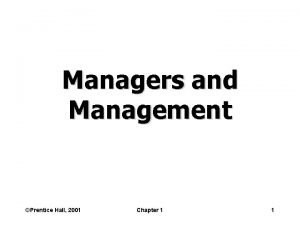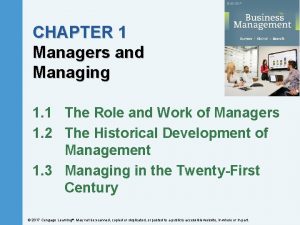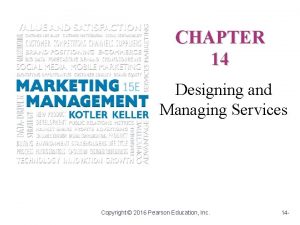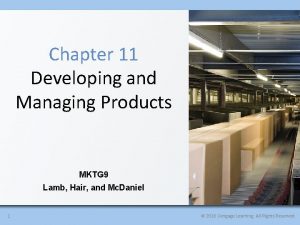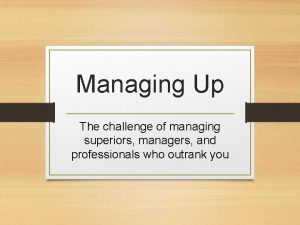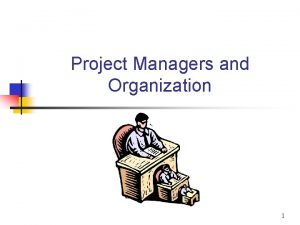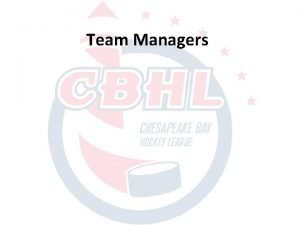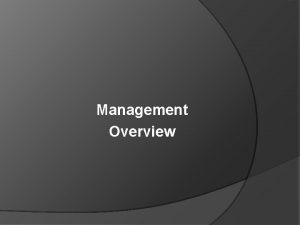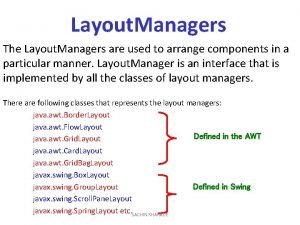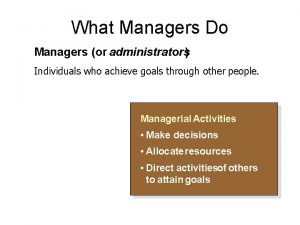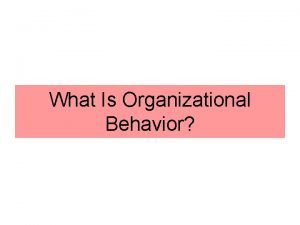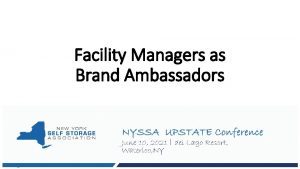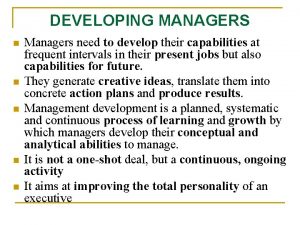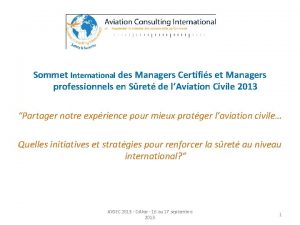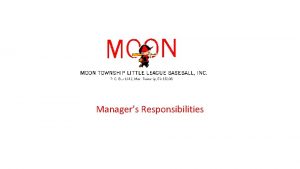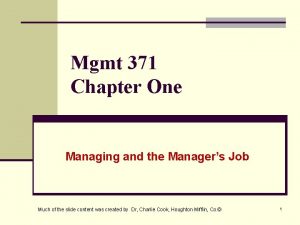CHAPTER 1 Managers and Managing 1 1 The































- Slides: 31

CHAPTER 1 Managers and Managing 1. 1 The Role and Work of Managers 1. 2 The Historical Development of Management 1. 3 Managing in the Twenty-First Century © 2017 Cengage Learning®. May not be scanned, copied or duplicated, or posted to a publicly accessible website, in whole or in part.

1. 1 The Role and Work of Managers CHAPTER 1 Learning Outcomes 1. 1. 1 Define management and the functions all managers complete. 1. 1. 2 Differentiate the work of several levels of management. © 2017 Cengage Learning®. May not be scanned, copied or duplicated, or posted to a publicly accessible website, in whole or in part. Slide 2

CHAPTER 1 Key Terms ● management ● planning ● organizing ● staffing ● leading ● controlling ● manager ● supervisor ● executive ● middle manager © 2017 Cengage Learning®. May not be scanned, copied or duplicated, or posted to a publicly accessible website, in whole or in part. Slide 3

Moving into Management CHAPTER 1 ● The Changing Nature of Management ● Management Activities • Management is the process of accomplishing the goals of an organization through the effective use of people and other resources. • Planning involves analyzing information and making decisions about what needs to be done. © 2017 Cengage Learning®. May not be scanned, copied or duplicated, or posted to a publicly accessible website, in whole or in part. Slide 4

Moving into Management CHAPTER 1 (continued) ● Management Activities (continued) • Organizing is concerned with determining how plans can be accomplished most effectively and arranging resources to complete work. • Staffing focuses on finding individuals with the right skills to do the work. © 2017 Cengage Learning®. May not be scanned, copied or duplicated, or posted to a publicly accessible website, in whole or in part. Slide 5

Moving into Management CHAPTER 1 (continued) ● Management Activities (continued) • Leading requires working with employees to ensure they are motivated and have the resources needed to help carry out plans and get the work done. • Controlling involves evaluating results to determine if the company’s objectives have been accomplished as planned. © 2017 Cengage Learning®. May not be scanned, copied or duplicated, or posted to a publicly accessible website, in whole or in part. Slide 6

CHECKPOINT CHAPTER 1 ● What are the five management functions that all managers complete? • • • Planning Organizing Staffing Leading Controlling © 2017 Cengage Learning®. May not be scanned, copied or duplicated, or posted to a publicly accessible website, in whole or in part. Slide 7

The Work of Managers CHAPTER 1 ● Managers and Non-management Employees • Managers are people who complete all five management functions on a regular basis and have authority over other jobs and people. ● Levels of Management • Supervisors are managers whose main job is to direct the work of employees. © 2017 Cengage Learning®. May not be scanned, copied or duplicated, or posted to a publicly accessible website, in whole or in part. Slide 8

The Work of Managers CHAPTER 1 (continued) ● Levels of Management (continued) • Executives are top-level managers who spend almost all of their time on management functions and decisions that affect the entire company. • Middle managers complete all of the management functions, but spend most of their time completing specialized work in one management function or are responsible for a specific part of the company’s operations. © 2017 Cengage Learning®. May not be scanned, copied or duplicated, or posted to a publicly accessible website, in whole or in part. Slide 9

Management Pyramid © 2017 Cengage Learning®. May not be scanned, copied or duplicated, or posted to a publicly accessible website, in whole or in part. CHAPTER 1 Slide 10

How Managers Spend Their Time © 2017 Cengage Learning®. May not be scanned, copied or duplicated, or posted to a publicly accessible website, in whole or in part. CHAPTER 1 Slide 11

CHECKPOINT CHAPTER 1 ● How is the work of supervisors different from the work of middle managers and executives? • Supervisors are typically the first level of management and often have many nonmanagerial activities to perform. • Middle managers usually specialize in one part of the business or a management function. • Executives are at the top of the company and focus on planning and organizing decisions that affect the entire company. © 2017 Cengage Learning®. May not be scanned, copied or duplicated, or posted to a publicly accessible website, in whole or in part. Slide 12

1. 2 The Historical Development of Management CHAPTER 1 Learning Outcomes 1. 2. 1 Describe historical changes in management that led to the beginning of management science. 1. 2. 2 Describe four different philosophies that have been used to manage organizations. © 2017 Cengage Learning®. May not be scanned, copied or duplicated, or posted to a publicly accessible website, in whole or in part. Slide 13

Key Terms CHAPTER 1 ● Industrial Revolution ● management science ● classical management ● administrative management ● behavioral management ● quality management © 2017 Cengage Learning®. May not be scanned, copied or duplicated, or posted to a publicly accessible website, in whole or in part. Slide 14

Management Through the Ages CHAPTER 1 ● The Earliest Forms of Management ● The Industrial Revolution • Industrial Revolution was the era of the eighteenth and nineteenth centuries in which machine power replaced human and animal power in the production process, leading to major business and social changes. ● Henry Ford’s Revolution © 2017 Cengage Learning®. May not be scanned, copied or duplicated, or posted to a publicly accessible website, in whole or in part. Slide 15

CHECKPOINT CHAPTER 1 ● How did the Industrial Revolution change the way work was done? • Machine power replaced human and animal power in the production process. • Rather than individual craftsmen completing the work on each product, businesses could hire several employees to operate the new machines. • The result was greater production and a larger number of products for sale. © 2017 Cengage Learning®. May not be scanned, copied or duplicated, or posted to a publicly accessible website, in whole or in part. Slide 16

Changing Approaches to Management CHAPTER 1 ● Management science is the careful, objective study of management decisions and procedures in order to improve the operation of businesses and organizations. ● Theories of Management • Classical management studies the way work is organized and the procedures used to complete a job in order to increase worker productivity. © 2017 Cengage Learning®. May not be scanned, copied or duplicated, or posted to a publicly accessible website, in whole or in part. Slide 17

Changing Approaches to Management (continued) CHAPTER 1 ● Theories of Management (continued) • Administrative management identifies the most effective practices for organizing and managing a business. • Behavioral management is directed at organizational improvement through understanding employee motivation and behavior. © 2017 Cengage Learning®. May not be scanned, copied or duplicated, or posted to a publicly accessible website, in whole or in part. Slide 18

Changing Approaches to Management (continued) CHAPTER 1 ● Theories of Management (continued) • Quality management is a total commitment by everyone in an organization to improve the quality of procedures and products by reducing waste, errors, and defects. © 2017 Cengage Learning®. May not be scanned, copied or duplicated, or posted to a publicly accessible website, in whole or in part. Slide 19

CHECKPOINT CHAPTER 1 ● What are the differences among the four theories of management? • Classical management studies the way the work is organized and the procedures used to complete a job in order to increase work productivity. • Administrative management identifies the most effective practices for organizing and managing a business. © 2017 Cengage Learning®. May not be scanned, copied or duplicated, or posted to a publicly accessible website, in whole or in part. Slide 20

CHECKPOINT (continued) CHAPTER 1 ● What are the differences among the four theories of management? (continued) • Behavioral management is directed at organizational improvement through understanding employee motivation and behavior. • Quality management is a total commitment by everyone in an organization to improve the quality of procedures and products by reducing waste, errors, and defects. © 2017 Cengage Learning®. May not be scanned, copied or duplicated, or posted to a publicly accessible website, in whole or in part. Slide 21

1. 3 Managing in the Twenty. First Century CHAPTER 1 Learning Outcomes 1. 3. 1 Describe ways that the workforce and work are changing. 1. 3. 2 Discuss important factors that influence the management strategy of an organization. © 2017 Cengage Learning®. May not be scanned, copied or duplicated, or posted to a publicly accessible website, in whole or in part. Slide 22

Key Terms CHAPTER 1 ● business competition ● management strategy © 2017 Cengage Learning®. May not be scanned, copied or duplicated, or posted to a publicly accessible website, in whole or in part. Slide 23

Changes and Challenges for Managers CHAPTER 1 ● Workers • Baby Boomer Retirements © 2017 Cengage Learning®. May not be scanned, copied or duplicated, or posted to a publicly accessible website, in whole or in part. Slide 24

Projected Changes in the Age of the U. S. Workforce © 2017 Cengage Learning®. May not be scanned, copied or duplicated, or posted to a publicly accessible website, in whole or in part. CHAPTER 1 Slide 25

Projected Changes in the Ethnicity of the U. S. Workforce © 2017 Cengage Learning®. May not be scanned, copied or duplicated, or posted to a publicly accessible website, in whole or in part. CHAPTER 1 Slide 26

Changes and Challenges for Managers (continued) CHAPTER 1 ● Work ● Competition • Business competition is the rivalry among companies for customers. ● Technology © 2017 Cengage Learning®. May not be scanned, copied or duplicated, or posted to a publicly accessible website, in whole or in part. Slide 27

CHECKPOINT CHAPTER 1 ● How will the U. S. workforce be different in 2050 than it was in 2010? • Older workers will make up a larger portion of the workforce while the youngest workers will obtain more education before entering the workforce. • Black, Hispanic, and Asian workers will make up nearly half the workforce in 2050. © 2017 Cengage Learning®. May not be scanned, copied or duplicated, or posted to a publicly accessible website, in whole or in part. Slide 28

Developing a Management Strategy CHAPTER 1 ● Management strategy is a carefully developed overall approach to leading an organization. ● The Business ● The Work ● The Business Environment ● The Management ● Moving Into Management © 2017 Cengage Learning®. May not be scanned, copied or duplicated, or posted to a publicly accessible website, in whole or in part. Slide 29

Developing a Management Strategy © 2017 Cengage Learning®. May not be scanned, copied or duplicated, or posted to a publicly accessible website, in whole or in part. CHAPTER 1 Slide 30

CHECKPOINT CHAPTER 1 ● What is a management strategy? • A management strategy is a carefully developed overall approach to leading an organization. © 2017 Cengage Learning®. May not be scanned, copied or duplicated, or posted to a publicly accessible website, in whole or in part. Slide 31
 Chapter 1 managers and managing
Chapter 1 managers and managing Managers and management chapter 1
Managers and management chapter 1 A carefully developed overall approach to leading
A carefully developed overall approach to leading Chapter 8 managing stress and anxiety
Chapter 8 managing stress and anxiety Chapter 4 managing stress and coping with loss notes
Chapter 4 managing stress and coping with loss notes Chapter 6 managing weight and body composition
Chapter 6 managing weight and body composition Why should teen athletes avoid performance enhancers?
Why should teen athletes avoid performance enhancers? Chapter 11 lesson 2 body image and eating disorders
Chapter 11 lesson 2 body image and eating disorders Chapter 11 health vocabulary
Chapter 11 health vocabulary Chapter 6 managing weight and body composition
Chapter 6 managing weight and body composition 7 types of jaycustomers
7 types of jaycustomers Chapter 11 managing weight and eating behaviors answer key
Chapter 11 managing weight and eating behaviors answer key Chapter 4 managing stress and coping with loss
Chapter 4 managing stress and coping with loss Services are typically produced and consumed simultaneously
Services are typically produced and consumed simultaneously Chase demand strategy
Chase demand strategy Developing and managing products
Developing and managing products Chapter 4 lesson 2 managing stress answer key
Chapter 4 lesson 2 managing stress answer key Managing change and innovation
Managing change and innovation Managing weight and eating behaviors
Managing weight and eating behaviors Chapter 4 managing stress and coping with loss
Chapter 4 managing stress and coping with loss Chapter 7 managing risk vision and perception
Chapter 7 managing risk vision and perception Chapter 6 managing weight and body composition
Chapter 6 managing weight and body composition The calm waters metaphor
The calm waters metaphor Hát kết hợp bộ gõ cơ thể
Hát kết hợp bộ gõ cơ thể Slidetodoc
Slidetodoc Bổ thể
Bổ thể Tỉ lệ cơ thể trẻ em
Tỉ lệ cơ thể trẻ em Gấu đi như thế nào
Gấu đi như thế nào Tư thế worm breton là gì
Tư thế worm breton là gì Hát lên người ơi alleluia
Hát lên người ơi alleluia Các môn thể thao bắt đầu bằng tiếng nhảy
Các môn thể thao bắt đầu bằng tiếng nhảy Thế nào là hệ số cao nhất
Thế nào là hệ số cao nhất

